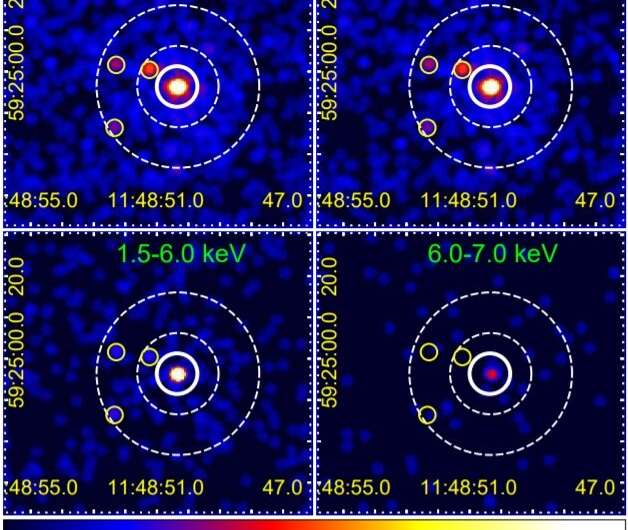July 5, 2021 report
Study investigates X-ray emission from the galaxy NGC 3894

Using NASA's Chandra spacecraft, astronomers have inspected X-ray emission from the center of a young radio galaxy known as NGC 3894. Results of this study, presented in a paper published June 24 on the arXiv pre-print server, yield essential information that could shed more light on the nature of this galaxy and its X-ray emission.
Radio galaxies emit huge amounts of radio waves from their central cores. Black holes at the centers of these galaxies accrete gas and dust, generating high-energy jets visible in radio wavelengths, which accelerate electrically charged particles to high velocities.
Astronomers are especially interested in studying gamma-ray bright radio galaxies as they can provide a unique opportunity to probe the high-energy emitting sites and particle acceleration processes. These sources are observed off-axis, which allows researchers to transversely resolve the fine scale structure of the jet and to investigate its connection with gamma-ray emission.
At a redshift of approximately 0.01, NGC 3894 is an elliptical galaxy hosting a compact radio source designated 1146+596. Observations of 1146+596/NGC 3894 suggest that it is one of the nearest and the youngest low-power radio galaxies. It is also one of only several young radio galaxies detected in the high-energy gamma-ray range.
Although many observations of 1146+596/NGC 3894 have been conducted at radio, infrared, optical and gamma-ray ranges, it lacks any detailed X-ray spectroscopy and imaging. So a team of astronomers led by Karthik Balasubramaniam of the Astronomical Observatory of the Jagiellonian University in Kraków, Poland, investigated the source in X-rays by analyzing the data from the Advanced CCD Imaging Spectrometer (ACIS) detector aboard Chandra.
"Here, we report on the analysis of the archival Chandra X-ray Observatory data for the central part of the galaxy, consisting of a single 40 ksec-long exposure," the researchers wrote in the paper.
The study found that the core spectrum is best fitted by a combination of a collisionally ionized thermal plasma with the temperature of around 0.8 keV, and a moderately absorbed power-law component. The soft thermal component turned out to be extended on the scale of the galaxy host, while the hard X-ray emission (within the photon energy range 6.0–7.0 keV) seems to originate within the unresolved core.
The research revealed the iron K-alpha line at approximately 6.47 keV, with a relatively large equivalent width of about 1 keV. The iron line is most likely indicative of the X-ray reflection from a cold neutral absorber in the central regions of NGC 3894. The astronomers added that this finding makes NGC 3894 the first high-energy gamma-ray source with the detected K-alpha iron line.
The study also found that the mass of the black hole in the system is about 2 billion solar masses, and that the minimum kinetic power of compact jets in 1146+596 is at a level of 2 tredecillion erg/s.
More information: X-ray Emission of the γ-ray Loud Young Radio Galaxy NGC 3894, arXiv:2106.13193 [astro-ph.HE] arxiv.org/abs/2106.13193
© 2021 Science X Network





















